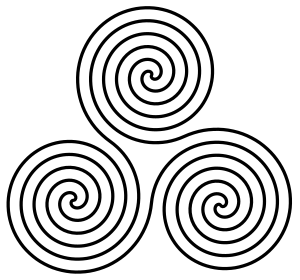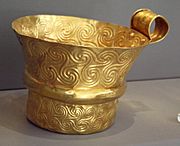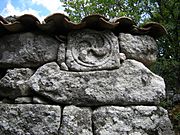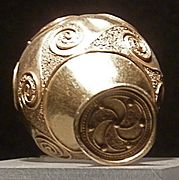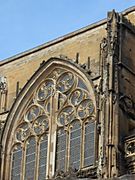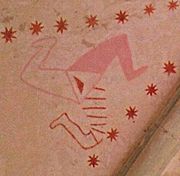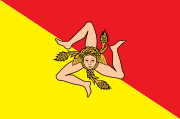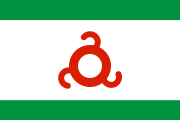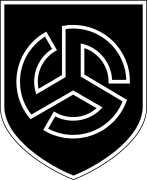Triskelion facts for kids
A triskelion (also called triskeles) is an ancient design that looks like a triple spiral or three bent human legs. These parts all come from a central point and show rotational symmetry, meaning they look the same when rotated.
The spiral design often uses three spirals that link together. This symbol has been found in Europe from the Stone Age and Bronze Age. It continued to be used into the Iron Age, especially by the Celtic cultures.
The triskeles symbol, which looks like three human legs, was very popular in Ancient Greece. It appeared on old pottery and later on coins.
During the Hellenistic period, this symbol became linked to the island of Sicily. It was put on coins there around c. 382 BCE. Later, it was used in heraldry, which is the study of coats of arms. Today, you can see it on the flag of Sicily and the Isle of Man flag.
The Greek word τρισκελής (triskelḗs) means "three-legged." The word "triskelion" is a smaller version of this word.
Contents
Ancient Uses of the Triskelion
From Stone Age to Iron Age

The triple spiral symbol has been found in many early cultures. One of the oldest examples is from Malta (around 4400–3600 BCE). Another famous one is at the ancient tomb of Newgrange in Ireland, built around 3200 BCE. This symbol is carved into a stone near the main entrance of the Newgrange monument. It also appears on old pots from Mycenae.
Archaeologists also found a triskelion on a stone piece in England, which is thought to be from the Stone Age or Bronze Age. The triskelion was also a common design in the art of the Celtic La Tène culture during the Iron Age.
Classical Times
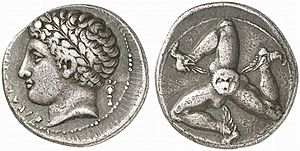
The triskeles symbol, made of three human legs, is newer than the triple spiral. It was used to decorate Greek pottery, especially on shields carried by soldiers. Later, it was also put on Greek and Anatolian coins.
One early example is on the shield of the hero Achilles in a Greek pot from the late 6th century BCE. It was also found on coins from places like Lycia and Pamphylia. The exact meaning of the Greek triskeles is not fully known. Some experts believe it might have represented a "triple goddess."
The leaders of Syracuse adopted the triskeles as their symbol. This might be because the Greek name for Sicily was Trinacria, which means "having three headlands" (points of land sticking out into the sea). The Sicilian triskeles often has the head of Medusa in its center.
This ancient symbol has been brought back into modern flags of Sicily since 1848. The oldest triskeles found in Sicily is on a vase from 700 BCE, which might have come from the Minoan-Mycenaean cultures.
Roman Period and Later
Later examples of the triple spiral symbol are found in Iron Age Europe, carved into rocks in places like Galicia and Northern Portugal. In Ireland, before the 5th century, the symbol took on a new meaning in Celtic Christianity. It became a symbol of the Trinity (Father, Son, and Holy Spirit).
Medieval Uses
The triple spiral design was used as a decoration in Gothic architecture during the Middle Ages. The three-legged triskeles symbol was not as common in medieval heraldry. However, it was used as the symbol for the King of Mann around 1280. It also appeared on the city seal of Füssen, Germany, in 1317.
Modern Uses
The triskeles was part of the design for the Army Gold Medal, given to British Army officers after the Battle of Maida in 1806.
An early flag of Sicily from 1848 included the Sicilian triskeles. Later versions of Sicily's flag still use this symbol, including the official one adopted in 2000. The Flag of the Isle of Man (from 1932) also shows a triskeles of three armored legs.
The German town of Füssen uses a triskeles on its flag and coat of arms. The flag of the Russian region of Ust-Orda Buryat Okrug also features it.
Some modern pagan groups use the spiral triskeles as a "Celtic symbol." It is especially important for groups interested in Celtic culture. They use it to represent different sets of three in their beliefs.
Other uses of triskelion-like symbols include the logo for the Trisquel Linux distribution (a type of computer operating system) and the seal of the United States Department of Transportation.
Some groups with extreme views have adopted a specific version of the triskeles. For example, the Afrikaner Weerstandsbeweging (AWB) in South Africa, a neo-Nazi group, uses a triskeles made of three sevens as its symbol instead of a swastika.
Found in Nature
The boric acid molecule has a triskelion shape. Also, a protein called clathrin is shaped like a triskelion. The ancient organism Tribrachidium also had a triskelion shape.
-
A molecule of boric acid
Gallery
Ancient Times
-
Triskelion of Sicily from the Minoan period (in the archaeological museum of Agrigento)
-
A gold cup from Mycenae decorated with triskelions, in the National Archaeological Museum of Athens.
-
An Iron Age Castro culture triskele, reused in a barn in Galicia
-
Triskelion and spirals on a Galician torc (a type of necklace)
Medieval Times
-
A mural showing a triskelion on the ceiling of Karja church in Saaremaa, Estonia
Modern Times
-
Flag of Sicily, with the triskeles and Gorgoneion symbol
-
Flag of Afrikaner Weerstandsbeweging
See also
 In Spanish: Trisquel para niños
In Spanish: Trisquel para niños
- Mitsudomoe


